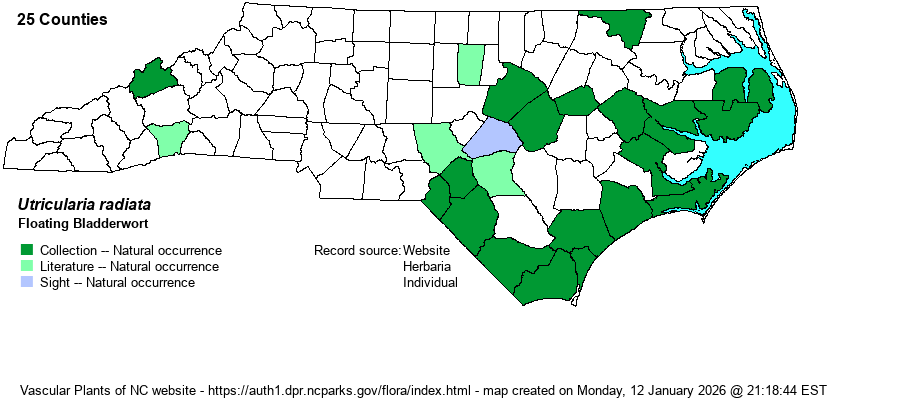| Author | Small | |
| Distribution | Widely scattered over the Coastal Plain, with several large holes, though potentially could occur in all counties there. Compared with the very similar U. inflata, which is more numerous in the Sandhills and southwestern portions of the province, this species is somewhat more widespread in coastal counties. West of the Coastal Plain known only from a few counties, including one or two from the eastern Piedmont and two (Madison and Henderson) from the Mountains.
This is another primarily Coastal Plain bladderwort species, being found from eastern Canada south in coastal states to southern FL and west to eastern TX. It is disjunct to several states away from the coasts, such as IN, TN, AR, and OK. | |
| Abundance | Infrequent in the lower Coastal Plain, most regular in coastal counties from Dare to Brunswick. Rare to uncommon farther north and west in the Coastal Plain, and rare in the Sandhills. Extremely rare in the Piedmont and Mountains. Thousands of plants flowered during high water period of 2019 at Big Cypress Meadow in Scotland County. | |
| Habitat | Essentially the same as for U. inflata -- lakes, ponds, and wet ditches, almost always in still water at least several inches deep. |
| Phenology | Blooms from May to November, and fruits shortly after flowering. | |
| Identification | This species and the very similar U. inflata, which have been included as one species in the past, are quite different from the rest of the bladderworts in the state. Each of these has expanded "floats" from the long flowering stalk, and these extend outward like spokes on a wheel along the top of the water surface. U. radiata has the floats nearly parallel-sided from the widest part of the float to the stem, whereas U. inflata has the floats gradually tapering to the stem (from the middle of the expanded portion). Also, this species has an average of 3-4 flowers, as opposed to the more flowers in the inflorescence, typically 9-14, of U. inflata. In general, U. inflata is a more attractive plant when in bloom, not only for its more flowers, but the flowers average more golden or bright yellow than the lighter yellow flowers of U. radiata; and also U. inflata has flowers about 2/3-inch across as opposed to about 1/2" across in U. radiata. Lastly, the flowering scape of U. inflata is taller, being about 9-10 inches tall, as opposed to the shorter stalk of U. radiata at roughly 5-6 inches tall. These two could grow together in the same pond or lake, but seldom does that seem to occur, as the ranges in the state are a bit different, though each is essentially a Coastal Plain species. | |
| Taxonomic Comments | This species was often included within U. inflata for much of the past century. In RAB (1968), it was listed as a variety, though named there as U. inflata var. minor. Nearly all recent references list both as full species, with no varieties.
| |
| Other Common Name(s) | Small Floating Bladderwort, Small Swollen Bladderwort | |
| State Rank | S3? [S3] | |
| Global Rank | G4 | |
| State Status | | |
| US Status | | |
| USACE-agcp | OBL link |
| USACE-emp | OBL link |

